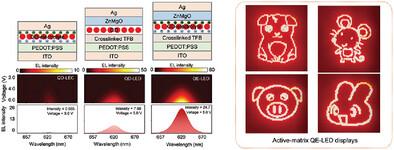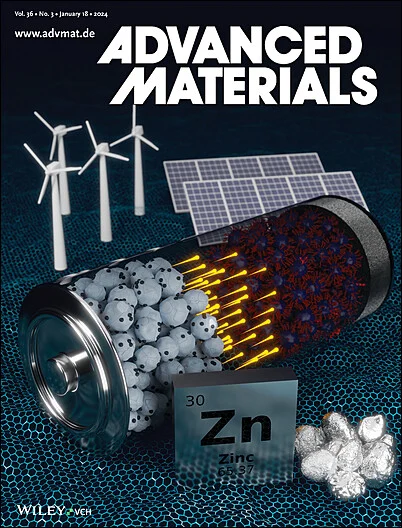Quantum-Dot-Electrolyte Light-Emitting Diodes for Displays
IF 27.4
1区 材料科学
Q1 CHEMISTRY, MULTIDISCIPLINARY
引用次数: 0
Abstract
Electroluminescence (EL) is essential for modern technologies, such as displays, lighting, and optical communications. To date, some kinds of artificial EL devices have been developed, including organic light-emitting diodes (OLEDs), quantum-dot (QD) LEDs, and light-emitting electrochemical cells. However, issues (e.g., inefficient charge injection, exciton quenching) limit the further EL performance. Here, another promising kind of EL device is reported, which is called QD-electrolyte LED (QE-LED). The key feature of QE-LED is that an ionic liquid is doped into QDs as the electrolyte emitter of multi-layer device architectures. Both theoretical and experimental analyses reveal that an enhanced interface electric field from the in situ formed electrical double layer is leveraged to improve the charge injection and transport. With the introduction of insulating polymers into QD-electrolyte emitters, red QE-LED achieves an external quantum efficiency of 20.5% and a lifetime (T95) over 3.74 × 105 h at the display-related luminance of 100 cd m−2, indicating that the QE-LED is among the best EL devices. Furthermore, an active-matrix QE-LED display is demonstrated with superior stability that overtakes the commercial benchmark. These results offer an avenue to discover unexplored EL devices and provide potential pathways to enhance charge dynamics for EL devices.

求助全文
约1分钟内获得全文
求助全文
来源期刊

Advanced Materials
工程技术-材料科学:综合
CiteScore
43.00
自引率
4.10%
发文量
2182
审稿时长
2 months
期刊介绍:
Advanced Materials, one of the world's most prestigious journals and the foundation of the Advanced portfolio, is the home of choice for best-in-class materials science for more than 30 years. Following this fast-growing and interdisciplinary field, we are considering and publishing the most important discoveries on any and all materials from materials scientists, chemists, physicists, engineers as well as health and life scientists and bringing you the latest results and trends in modern materials-related research every week.
 求助内容:
求助内容: 应助结果提醒方式:
应助结果提醒方式:


